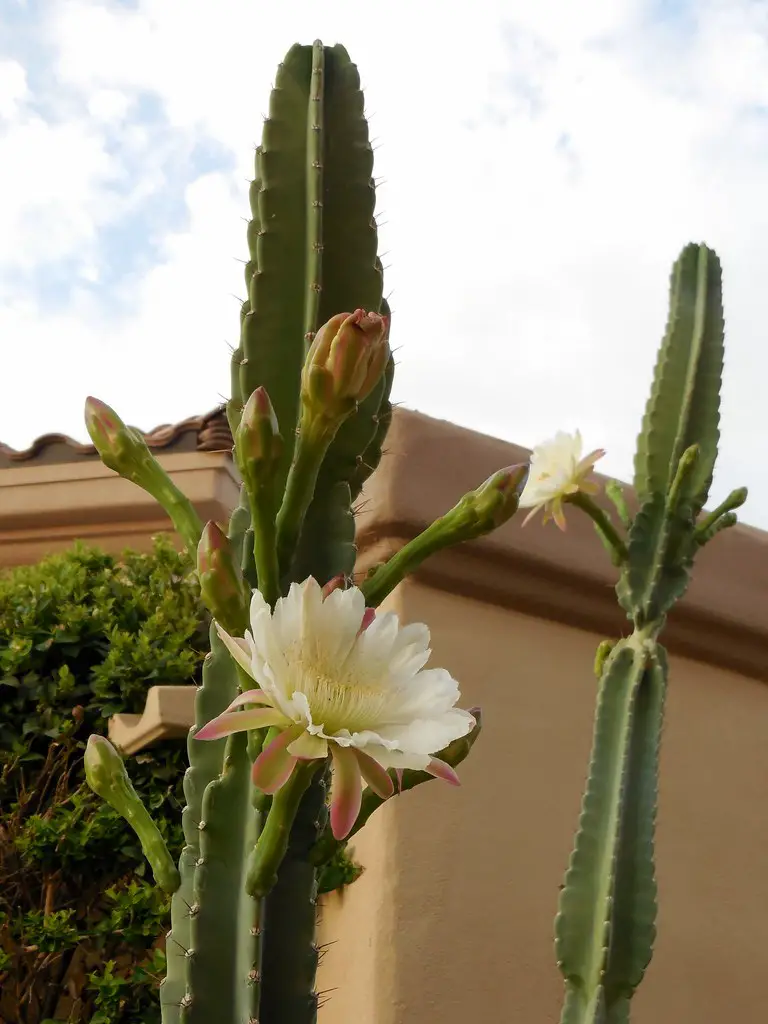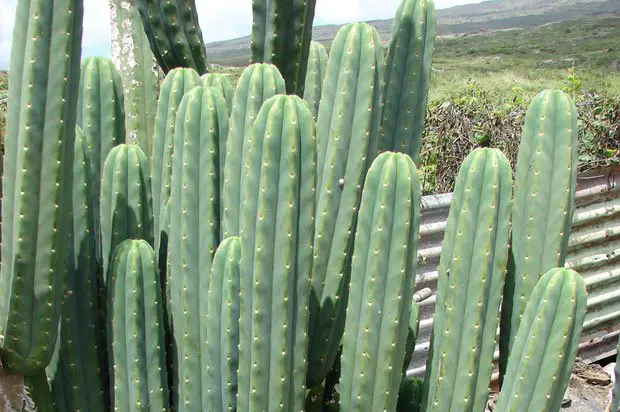The Peruvian torch and San Pedro cacti are so similar that the two species are almost synonymous with each other. However, there are differences that you would want to know.
Let’s know some more facts about these two cacti.
What is Peruvian Torch? – About Peruvian Torch

- Peruvian torch cactus is also known popularly as Echinopsis Peruviana or Trichocereus Peruviana (Latin names), Peruvian Apple, Peruvian Apple Cactus, and Apple Cactus.
- It is a species of cacti native to the Andes mountain regions of Ecuador, Peru, and Bolivia.
- It grows rapidly about 1 to 2 feet (0.3 to 0.6 meters) per year and can be found at an altitude of 1,000 to 3,000 feet (0.3 to 0.91 kilometers).
- The Peruvian torch cactus is a columnar, bluish-green cactus with reddish-brown spines that grows up to a height of 5 meters (16 feet).
- Torch cacti are robust plants that are cultivated by the Inca people indigenous to Peru and their antecedents of up to 900 BC for holy rituals.
- Among cacti, it is the utmost hallucinogenic, with the compound mescaline in the amount of about 0.5% once totally dried. There is a popular question on the internet “is Peruvian Torch psychoactive”, and the answer should be “Yes” it is. Because this contains Mescaline which is a natural hallucinating drug.
- They are used as fencing, in cacti and succulent gardens, in pots when small, in clusters in dry parts of the garden, and in rock gardens.
Care Of Peruvian Torch
- Echinopsis Peruviana (Peruvian Torch) likes lots of sun and hot, dry climates.
- It can endure intermittent frosts and in winters, the minimum temperature resistance is 5ºC.
- Peruvian torch grows well in sandy soil that is well-draining and contains organic matter. Early spring is the best time for pot transplantation.
- Water adequately and wait for the substrate to dry before the next watering; avoid watering from mid-fall to early spring.
- Pruning is not required for the Peruvian torch.
- Fertilize in early spring using compost and in summers, use a cactus fertilizer once a month.
- Avoid over-watering to keep pests and diseases away from Peruvian Torch.
- Propagation by cuttings can be done easily in spring and propagation by seeds is the slow and complicated process
What is San Pedro?

San Pedro Cactus is a rapid-growing columnar cactus that is native to the Andes Mountains. It is found in Argentina, Bolivia, Colombia, Chile, Ecuador, and Peru, and it is cultivated in other parts of the world.
Features:
- San Pedro is a columnar cactus with a few spines growing 10 to 20 feet tall.
- A single stem soon grows pups and branches, forming a stunning clump of fast-growing pinnacles with astute appearance.
- Contrary to other columnar cacti, San Pedro is getting increasingly popular to grow in patios and passageways, indoors, in pots, and in sunny places.
- San Pedro is a native to the Andes mountains of South America (Argentina, Bolivia, Chile, Colombia, Ecuador, and Peru).
- It contains mescaline—a psychoactive compound that was the first to be labeled as “psychedelic”. In short, Mescaline is also known as 3,4,5-trimethoxyphenethylamine which is hallucinating drug that occurs naturally in San Pedro.
- For thousands of years, San Pedro has been an integral element of the spiritual celebrations of various primitive cultures.
- In these ceremonies, the San Pedro experience is known to be similar to MDMA and possibly life-changing, encouraging thorough contemplation, therapeutic, and a sense of bewilderment.
- Customarily, San Pedro has been eaten either single or with other plants in a ritual brew called cimora. Using San Pedro as a psychedelic is unlawful in the US; the plant can be seen adorning farms and gardens throughout the country.
- It is also found in ample quantities as San Pedro or Huachuma at the witches’ markets of Peru, as Achuma in Bolivia, and as Aguacolla or Giganton in Ecuador.
- San Pedro is a powerful psychedelic, and a San Pedro ceremony can be profound and bittersweet. Consuming San Pedro will give everyone a unique experience, but some general things can be expected.
- Echinopsis pachanoi is a very ornate and disease-resistant plant. It can be propagated from seeds and cuttings.
Care of San Pedro Cactus
- San Pedro flourishes in direct sun, but seedlings may get sunburned in direct sun. Trichocereus pachanoi thrives in light shade in hot summers.
- Slowly introduce an overwintered indoor plant to direct sunlight, as they may be sunburnt if kept directly in the sun.
- San Pedro grown indoors will need additional lighting from grow lights.
- A healthy San Pedro can’t resist temperatures lower than 50° F (10° C) with sporadic dips as low as 15.8° F (-9° C). This cold resistance can be boosted by using Valerian flower extract.
- It can grow well in USDA hardiness zones 8B to 10B.
- Like other succulents, this cactus undergoes dormancy in winters. Avoid watering between October and April to lower the risk of rot.
- Seedlings can be given a very diluted mix of fertilizer from time to time, but give an undiluted concentration to the fully grown plants.
- Use a diluted liquid fertilizer to feed San Pedro and fertilize during the growing season only.
- Trichocereus pachanoi needs moderately acidic, fertile potting soil that is well-draining.
- A little bit of humus will lower the risk of rot.
- One-year-old seedlings can be transplanted to pots safely.
- For grafting or pupping, Trichocereus pachanoi can be clipped. Clip 12” inches or more, as bigger plants grow fast. No other grooming is required for a healthy plant.
- A little sulfur or diatomaceous earth can be added to the soil to use as a natural pesticide.
Head to Head Difference Between Peruvian Torch and San Pedro
| Peruvian Torch / Trichocereus Peruviana | San Pedro or Echinopsis/ Trichocereus Pachanoi |
| A fast-growing, bluish green, columnar cactus with a frosted stem and has 6 to 9 broadly rounded ribs.
It can grow up to 6 meters (20 feet) in height. |
The San Pedro cactus is a pale green to blue-green, multi-columnar small tree that grows fast, about 1 foot per year.
Each column is about 2.4 inches to 5.9 inches thick and has between 4 and 8 ribs each with upward-facing areoles.It can be 5 meters tall and have multiple branches, usually originating from the base |
| A native to the western slope of the Andes in Peru about 6,600–9,800 ft(2,000-3,000 m) above sea level. | It grows naturally in Argentina, Bolivia, Colombia, Chile, Ecuador, and Peru, and is also cultivated in other areas of the world. |
| The thorns of Peruvian Torch are reddish brown in color, much larger and grow with more width and firmness. | The thorns are light brown or dark yellow in color and smaller in size. |
| cactus produces edible fruit that tastes like dragon fruit. This fruit can be used to make wine."}”>Peruvian torch produces white flowers, but some varieties may produce red flowers. They bloom at first light. They produce flowers in large numbers of about 50 per specimen. The flowers last for two to three days.This cactus produces edible fruit that tastes like dragon fruit. This fruit can be used to make wine. |
San Pedro has pointed buds that bloom into fluted, whitish, fragrant flowers 8.7” inches in diameter in July. They bloom at night when the temperature lowers.The flowers are ephemeral and live only for a day. The fruit of San Pedro is mild flavoured and can be consumed. The fruits are covered with black or brown hairs and scales. |
| The Peruvian torch contains higher alkaloid mescaline than the San Pedro cactus. The Grandiflora of Peruvian torch cactus is consumed for psychedelic effects. | Psychedelic brew is obtained from cactus shavings. |
Traditional Medicine
Echinopsis Pachanoi contains hordenine, (N, N-Dimethyl-hydroxyphenylethylamine) that shows an hindrance against 18 strains of penicillin resistant Staphylococcus bacteria.
Echinopsis pachanoi is used to cure drug addictions, nervous conditions, cardiac disease, high blood pressure etc. It has special antimicrobial properties and it’s stem can be applied to heal wounds, scars, sinusitis, inflammation and fungal infections of the skin.
Veterinary Uses
San Pedro cactus are used for treating certain diseases and conditions in animals.
- Antiparasitic: In cattle and goats, boil the stems of San Pedro with alum and lime to get rid of tinea.
- Foot and mouth disease: The cactus stem is pressed to get a liquid that can be fed and applied to the infected part of the animal.
Other Uses
The extract of the stem can be used as a shampoo.
Laundry soap: Soak the cut stem and filter it with or without adding salt or alum to wash wool.
Alkaloids
San Pedro has many alkaloids, including the common chemical mescaline (0.21 – 1.8%), and also 3,4-dimethoxyphenethylamine,
4-hydroxy-3,5-dimethoxyphenethylamine, anhalonidine,
4-hydroxy-3-methoxyphenethylamine, 3-hydroxy-4,5-dimethoxyphenethylamine, anhalinine, hordenine, tyramine, and 3-methoxytyramine.
Mescaline
- Mescaline (3,4,5-trimethoxyphenethylamine) is a psychoactive drug (Hallucinating Drug) and entheogen, also found in certain other types of genus Echinopsis like Echinopsis peruviana, Echinopsis scopulicola, Echinopsis lageniformis and the species Lophophora williamsii (peyote).
- Informal evidence shows that the layers of green photosynthetic tissue under the skin have maximum concentrations of active substances.
- The alkaloids will be more in the dark green cactus which can be created by “stressing it” with less sunlight in shade or indoors, keeping a cut section indoors for 6+ weeks, dehydrate, and inoculate the plant with dopamine or a mixture of tyrosine and levodopa.
- Mescaline is practiced by Native American tribes in America because it occurs in a cactus species extensively in the deserts of the US state of Texas and Mexico, named as Peyote.
- Mescaline is procured from the compact, spineless cactus Peyote (Lophophora williamsii), Peruvian torch cactus, the San Pedro cactus, other mescaline-containing cacti, and some members of the Fabaceae (bean) family. It can also be made synthetically.
- Mescaline has an effect like LSD or psilocybin (magic mushrooms) or other hallucinogenic drugs.
- Some common effects after use are altered consciousness, visual hallucinations, euphoria, visualizations with open or closed eyes, dreamy mind state, laughter, mixed senses or synesthesia like hearing colors and dilation of pupils, etc.
- Side effects of mescaline use include increased heartbeat, anxiety, fear, dizziness, feeling weak, tremors, diarrhea, vomiting, nausea, sweating excessively, headache, panic or paranoia, psychosis accidental injury, seizures, amnesia (loss of memory), and post hallucinogenic perceptual disorders, etc.
- Mescaline is not addictive physically like other psychedelic hallucinogens, but a person can become tolerant i.e. higher doses are required to have the same hallucinogenic effect.
- Mescaline-containing cacti can trigger severe vomiting and nausea, which is an integral part of traditional Shaman or Native-American celebrations and is observed as a religious and cleansing ritual.
Extraction of Mescaline
Mescaline can be extracted by using various techniques:
1. Simple like boiling in water for 5 to 7 hours and complex e.g. an acid-base extraction.
2. The complex technique yields a substance with a remarkably higher concentration of mescaline
Conclusion
Mescaline-containing cacti are legal to grow, but they are prohibited from human consumption.
I do not support or disregard the illegal use of these plants. However, I assume that illegal drug use takes place. Also, I think that providing wholesome knowledge is important for the safety of people. Keeping this in mind, this article is structured for the well-being of those who choose to use the San Pedro cactus as a hallucinogen.
Hope you now know pretty well about the differences between these two similar-looking cacti Peruvian Torch, and San Pedro.
